


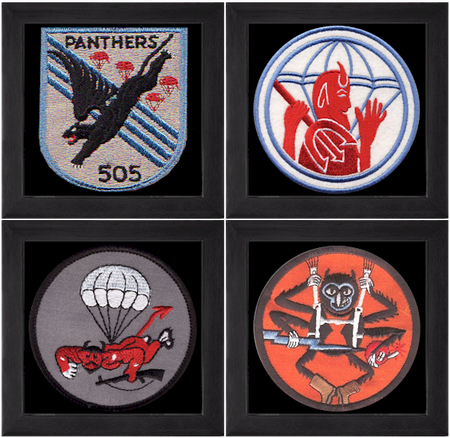


The double "A" on the shoulder patch refers to the nickname "All American Division" adopted by the organization in France during World War I.
On 25 March 1942,the 82nd Infantry Division was reactivated at Camp Claiborne, Louisiana under the command of Major General Omar N. Bradley (left). On August 15, 1942, the Division took wings as The 82nd Airborne - becoming the U.S. Army's first airborne division - now commanded by Major General Matthew B.Ridgway .
At the same time, 82nd personnel also were used in the formation of a second airborne unit - the "Screaming Eagles" of the 101st Airborne Division.
In October, the 82nd was dispatched to Fort Bragg, North Carolina, to pursue its new airborne training. On October 14, the 82nd absorbed the 504th Parachute Infantry Regiment, which had formed on May 1 at Fort Benning, Georgia. By the time that they went overseas, the 82nd would consist of the 325th Glider Infantry Regiment and the 504th and 505th Parachute Infantry Regiments.
At Fort Bragg, the All Americans trained vigorously. These pioneering paratroopers stood up, hooked up and leaped from C-47 transport planes while the gliderborne troops were at work in the 15-man WACO-CG4A gliders - towed by the transport planes.

In the spring of 1943, the 82nd All Americans became the first airborne division sent overseas. They left via troop ships from New England and landed in Casablanca, North Africa on May 10, 1943. From there, they moved by rail to Oujda and then by truck to Kairouan, Tunisia. That would be their departure point for the Division's first combat drop - the invasion of Sicily.
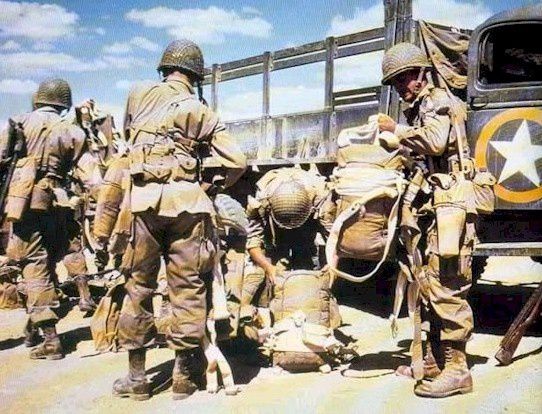
Colonel James Gavin's 505th Parachute Infantry Regiment (PIR) and the 3rd Battalion of the 504th PIR parachuted to take the high ground near Ponte Olivo airfield northeast of Gela, Sicily on July 9,1943. Despite the wide scattering of the assault, the objectives were seized and the units linked up with the 1st Infantry Division the next day.
On July 11, 1943, the remaining Battalions of the 504th PIR were dropped in the vicinity of Gela with heavy losses from both the German and Allied (friendly fire) antiaircraft fire. Despite the heavy losses the division was moved up to the front by motor and reinforced by the 39th Infantry Regiment of the 9th Infantry Division on July 12, 1943. The crossings of Fiume delle Canno were secured on July 18, 1943 and the division pushed along the coastal highway, seizing the Marsala-Trapani area of Sicily's western coast by July 23rd.
Salerno - The Oil Drum Drop
The Division's second combat operation was a night parachute drop onto the Salerno beachhead on September 13, 1943 in support of General Mark Clark's 5th Army which was in danger of being pushed back into the sea.
The 504th PIR was parachuted south of the Sele River near Salerno on September 13, 1943. In order to guide the C-47 pilots to the shrinking dropzone, oil drums filled with gasoline soaked sand were ignited every 50 yards when signaled. 1300 troopers landed that night infusing a new sense of confidence to the beleaguered soldiers of the 5th Army. The 505th PIR was dropped the following night near the same dropzone to reinforce the air assault. On September 15th the 325th Glider Infantry Regiment (GIR) was brought into the beachhead amphibiously to join the rest of the division.
Once the beachhead was secured, the 504th PIR & the 376th PFAB began an attack to recover Altavilla on September 16, 1943 and the division fought towards Naples which it reached on October 1, 1943 and moved in to the next day for security duty.
"Leg Infantry"
After Naples, the 504th PIR & the 376th PFAB were detached from the 82nd Airborne temporarily and fought as "leg infantry" through the hills of southern Italy as part of the 36th Infantry Division. On October 29th they capture Gallo. They then battled in the Winter Line commencing with attacks up Hill 687 on December 15th, 1943.
On 9 December 1943 Colonel Gavin was promoted to Brigadier General and assumed the duties of the Assistant Division Commander of the 82nd Airborne while Lt Col Herbert Batchellor assumed command of the 505th. During the early months of 1944, units of the Division were moved to England as the allies were preparing for the assault on Western Europe. The 505th PIR again changed commanders on 22 March 1944 when Lt Col William Ekman assumed command. He would lead the 505th through the remainder of the war.
Anzio - Operation Shingle
On January 22nd &23rd 1944, the 504th PIR, landed on the beach at Anzio and participated in heavy combat along the Mussolini Canal. It was their fierce fighting during this defensive engagement that earned the 504th PIR the nickname "Devils in Baggy Pants." The nickname was taken from an entry made in a German officer's diary.
D-Day - Operation Neptune
While the 504th was detached, the remainder of the 82nd was pulled out of Italy in December 1943 and moved to the United Kingdom to prepare for the liberation of Europe. With two combat jumps under its belt, the 82nd Airborne Division was now ready for the most ambitious airborne operation of the war, Operation Neptune -the airborne invasion of Normandy. The operation was part of Operation OVERLORD, the amphibious assault on the northern coast of Nazi-occupied France.
In preparation for the operation, the division was reorganized. Two new parachute infantry regiments, the 507th and the 508th, joined the division. However, due to its depleted state following the fighting in Italy, the 504th Parachute Infantry Regiment did not take part in the invasion.
On June 5-6, 1944, the paratroopers of the 82nd's three parachute infantry regiments and reinforced glider infantry regiment boarded hundreds of transport planes and gliders and, began the largest airborne assault in history. They were among the first soldiers to fight in Normandy, France.
The division dropped behind Utah Beach, Normandy, France between Ste Mere-Eglise and Carentan on June 6th, 1944. They were reinforced by the 325th GIR the next day. The division remained under strong German pressure along the Merderit River. Eventually, the 325th GIR crossed the river to secure a bridgehead at La Fiere on June 9th. It was during this action that Pfc Charles N. DeGlopper single-handedly defended his platoon's position and subsequently was awarded the Medal of Honor for his heroism.
The next day the 505th PIR captured Montebourg Station and on June 12th the 508th PIR crossed the Douve at Beuzeville-la-Bastille and reached Baupt. They established a bridgehead at Pont l'Abbe on June 19th. The division then attacked down the west coast of the Cotentin Peninsula and captured Hill 131 on July 3rd. The following day the 82nd seized Hill 95 overlooking La Haye-du-Puits.
By the time the All-American Division was pulled back to England on July 13, 1944, it had seen 33 days of bloody combat and suffered 5,245 paratroopers killed, wounded or missing. The Division's post battle report read, "...33 days of action without relief, without replacements. Every mission accomplished. No ground gained was ever relinquished."
Following the Normandy invasion, the 82nd became part of the newly organized XVIII Airborne Corps which consisted of the U.S. 17th, 82nd, and 101st Airborne Divisions. General Ridgway was promoted and assumed command of the XVIII Airborne Corps. Meanwhile, Assistant Division Commander, General James Gavin (picture left) was also promoted and assumed command of the 82nd Airborne.

Operation Market Garden
On September 17, the 82nd Airborne Division conducted its fourth combat jump of World War II into Holland. Fighting off ferocious German counterattacks, the 82nd captured the Maas Bridge at Grave, the Maas-Waal Canal Bridge at Heumen and the Nijmegen-Groesbeek Ridge. The next day attempts to take Nijmegen Highway Bridge failed.
On 20 September the 504th carried out an heroic assault crossing the Waal. With artillery support the first wave of the 504th assaulted, in twenty-six assault boats, under intense fire, taking 200 casualties in the process. Finally on D+4 the 504th finally secured their hold on the bridge, fighting off another German counterattack just before noon.
It was in this skirmish that Pvt. John Towle won the Medal of Honor. Its success, however, was short-lived because of the defeat of other Allied units at Arnhem. The gateway to Germany would not open in September 1944, and the 82nd was ordered back to France.

Battle of the Bulge - The Ardennes Offensive
Suddenly, on December 16, 1944, the Germans launched a surprise offensive through the Ardennes Forest which caught the Allies completely by surprise. The 82nd moved into action on December 17th in reponse to the German's Ardennes Counteroffensive and blunted General Von Runstedt's (picture left) northern penetration in the American lines. On December 20th the 82nd attacked in the Vielsalm-St. Vith region and the 504th PIR took Monceau. This fiece attack forced the German units back across the Ambleve River the next day.

However, further German assaults along the Salm hit the 505th PIR in the Trois Ponts area on December 22nd and by December 24th the division lost Manhay. On December 25th, 1944 the division withdrew from the Vielsalm salient then attacked northeast of Bra on December 27th reaching Salm by January 4th, 1945.
On January 7th the 508th PIR Red Devil's launched an attack with the 504th in the vicinity of Thier-du-Mont where it suffered heavy casualties. The 508th was then withdrawn from the line and placed in reserve until January 21st when it replaced elements of the 2d Infantry Division.
On January 29, 1945 First Sergeant Leonard Funk, Jr. of Company C, 508th Parachute Infantry Regiment won the Congressional Medal of Honor for action at Holzheim, Belgium. After leading his unit and capturing 80 Germans.
On February 7th, 1945 the division attacked Bergstein, a town on the Roer River. The 82nd crossed the Roer River on February 17th. During April, 1945 the division performed security duty in Cologne until they attacked in the Bleckede area and pushed toward the Elbe River. As the 504th PIR drove toward Forst Carrenzien, the German 21st Army surrendered to the division on May 2, 1945.

Occupation
Following the surrender of Germany, the 82nd was ordered to Berlin for occupation duty. In Berlin General George Patton was so impressed with the 82nd's honor guard he said, "In all my years in the Army and all the honor guards I have ever seen, the 82nd's honor guard is undoubtedly the best." Hence the "All-Americans" became known as "America's Guard of Honor."
The 82nd returned to the United States January 3, 1946. Instead of being demobilized, the 82nd made its permanent home at Fort Bragg, North Carolina and was designated a regular Army division on November 15, 1948.

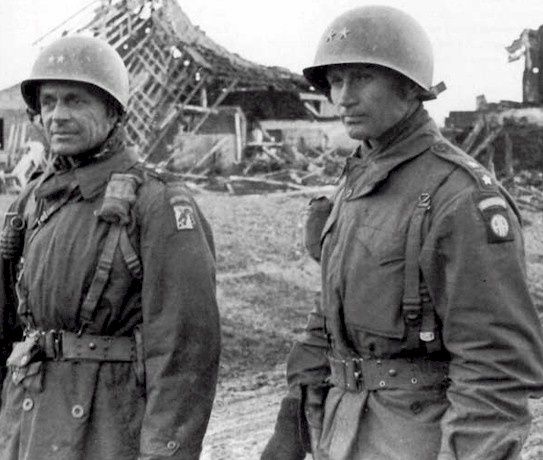
James Maurice "Jumpin' Jim" Gavin (born as James Nally Ryan- March 22, 1907-February 23, 1990) rose to the rank of Lieutenant General in the United States Army. He was also referred to as "The Jumping General", because of his practice of taking part in combat drops with the paratroopers he commanded.
Gavin was the youngest Major General commanding a division during World War Two.During combat, he was known for his habit of carrying an M1 Garand rifle, as opposed to the pistols traditionally carried by officers.
His men, who respected him a great deal, also called him "Slim Jim" due to his athletic figure. Gavin fought against segregation in the U.S. Army, which gained him some notoriety.
Amongst his decorations, he was awarded the Distinguished Service Cross with Oak Leaf Cluster, the Distinguished Service Medal, the Silver Star and the Purple Heart. He was also awarded the British Distinguished Service Order.

![]()


![]()






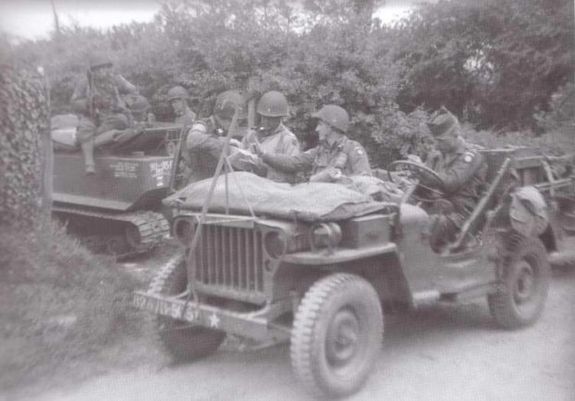


![]()

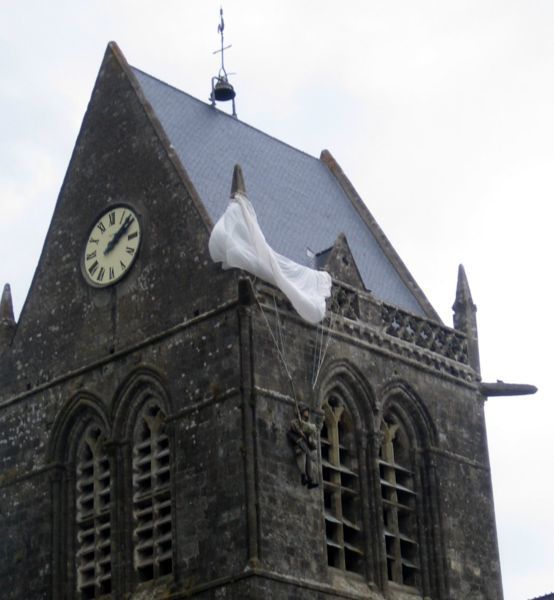
A famous incident involved paratrooper John Steele of the 505th PIR, whose parachute caught on the spire of the town church, and could only observe the fighting going on below. He hung there limply for two hours, pretending to be dead, before the Germans took him prisoner. Steele later escaped from the Germans and rejoined his division when US troops of the 3rd Battalion, 505 Parachute Infantry Regiment attacked the village capturing thirty Germans and killing another eleven.
The largest combined military operation in history,"D-Day", was to be spearheaded by the 82d and 101st Airborne Divisions. Visibility was hampered by poor weather conditions as the C-47's crossed the English Channel during the first hours of the 6th of June 1944.
When the troop carriers finally did made landfall on the Cherbourg Peninsula they came under heavy German flak scattering many of the troop carrier flights. It was 0300 hours on 6 June 1944, when the 505th were given the green light to jump.
Some Pathfinders were able to signal their dropzones. However, many of the troop carriers missed their dropzones and the All-Americansof the 505th began landing across a large swath of the countryside around Normandy.
Nevertheless, the 505th PIR was one of the first airborne units to hit the ground and despite the subsequent confusion surrounding the landing, were able to use it to their advantage mustering enough troops under the command of the 2nd Battalion Commander, Lt. Col. Benjamin Vandervoort to liberate the first town in France, - St. Mere-Eglise. The paratroopers jumped prior to the actual start of the invasion "H-Hour". Because of the tradition of being the first into the fight, the 505th Regimental motto is "H-MINUS".
For their performance in the invasions the 505th was awarded the Presidential unit citation, the unit equivalent of the Medal of Honor awarded to individual soldiers. In the words of author Clay Blair, the paratroopers emerged from Normandy with the reputation of being a pack of jackals; the toughest, most resourceful and bloodthirsty in Europe

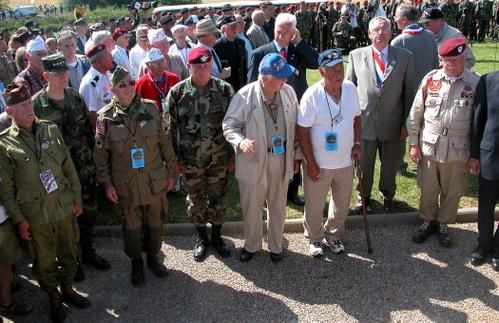

![]()
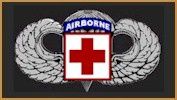
In the night of 5 – 6 June 1944, 8 jumpers from the 307th Airborne Medical Company parachuted into France with Division Headquarters! At 1852 hrs, the evening of 6 June, gliders towed by C-47s took off for Normandy carrying medical personnel pertaining to the 307th under command of Major W. H. Houston.
A total of 19 British Horsa and 1 American Waco CG4A gliders took off from England (part of Force “B”), flying over the Channel, and encountering only moderate enemy flak over the Cotentin peninsula. The main body of the Company landed together in swampy, half-flooded fields crisscrossed by small canals and ditches. By midnight a small Clearing Station was set up and casualties started coming in.
The next day, sad news was received that the 307th Airborne Medical Company’s Commander, Major William H. Houston, had been killed (KIA 6 Jun 44 at 2130 hrs)! He was replaced the same day by Captain Jerry J. Belden, XO. Three hours after landing, the Company began to treat casualties from the glider crashes as well as other airborne stragglers.
After changing locations three times, because of enemy interference, they started operating on a large scale as from 9 June, only one quarter mile south of Ste-Mere-Eglise … the only available vehicles were ¼ trucks (i.e. jeeps) and trailers brought along in the gliders.
On 10 June, the seaborne elements (Force “C”) joined the Company and made the assembly complete. About a half mile away, the 315th Medical Battalion (90th Infantry Division) suffered a direct bomb hit that interrupted its normal operation, and for the next 36 hours, the 307th took over their casualties as well.
By 22 June, medics had cleared over 3,000 casualties, and by 5 July, the number was over 4,200.
The Company was later set up across the Douve River (sixth location), providing medical care to the Division holding the bridgehead for more than 10 days. Later they were called upon to support VIII Corps during its frontal attack, suffering casualties from wounds and exhaustion in the process. Being still out at the Infantry Battalions, the 307th finally received some aid from VIII Corps who sent 60 aidmen and 5 ambulances to help the unit operate.
Operations were concluded on 11 July 1944. After spending a night on the beach in pup tents, the unit embarked from Utah Beach on 13 July, reaching Southampton, England, and proceeding by train, returned to its Leicester base the same day. Waiting for the 307th, was the biggest group of replacements that had so far joined the Company!
.
.

![]()




![]()
![]()
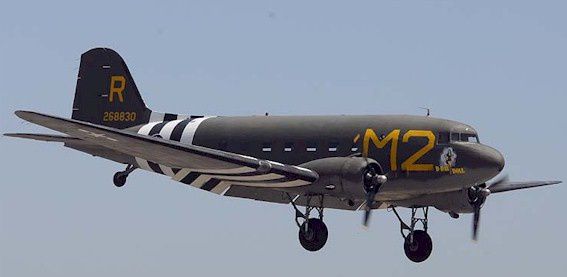
C-47 Skytrain
![]()


![]()

Lt., 82nd Airborne 1943
01 - M1 helmet with camouflage net
02 - M1942 jacket
03 - M1942 trousers
04 - M1934 wool shirt
05 - Corcoran boots
06 - M1936 main belt with M1916 holster for the Colt M1911 pistol
07 - M1936 webbing
08 - M1A1 carbine
09 - M2A1 gas mask
10 - M1910 folding shovel
11 - M1942 canteen
12 - M1910 bag
13 - dog tags
14 - M1918 Mk I knife
15 - M1936 backpack
![]()

Perhaps the most identifiable image among the American forces in Europe is the uniform and equipment of the Airborne soldier. The following is a piece by piece breakdown of the typical standard issue equipment and uniform given to American paratroopers during the Normandy Campaign. This is, however, by no means the only configuration of equipment issued, as many variations and improvised devices were used based on functionality and practicality. Total weight of all jump equipment exceeded 110 pounds.
M1C Paratrooper Helmet - The M1 steel helmet replaced the M1917A1 helmet in June of 1941. The shell is an OD#7 green color with a rough textured finish. Shade variations exist on original helmets from a light pea-green to almost black. WWII early war production shells can be identified by the location of the seam on the rim. The method of chin strap attachment is via a tack stitch to the loops of the shell. The steel shell was worn over the liner. There were multiple types and makes of liners, with many variations; too many to list here. The most common type was the compressed canvas resin impregnated liner with an HBT suspension. Earlier types were paper-fiber with rayon suspensions.
M1942 Paratrooper Jacket/Pants (Reinforced) - During early airborne operations in North Africa and Italy, the M1942 uniform was found to be lacking in several areas, most notably strength. The fabric is relatively thin and some seams should have had extra material added. The knees and elbows wore out easily, the pockets sometimes blew out due to the opening shock of parachutes and the single stitch in the crotch seam led to many tears in the "rear"
Sometime prior to Normandy, divisional riggers were directed to fix these problems. The riggers of the 82nd and 101st each came up with a similar though not quite identical fix. Heavy olive drab canvas was used to make elbow and knee patches, and reinforce the edges of the cargo pockets. Leg ties were added to the trousers to help compress the bulging hip pockets. Small variations exist in the way they are stitched between the 82nd and 101st, but they are essentially the same.
Jump Boots - Army jump boot design started by combining features from existing use by others, including German parachutists, units who started earlier than the U.S. and had already participated in combat in Europe, and U.S. Forest Service "smoke jumpers". The Marine Corps also had parachute units and experiments had shown the need for special footwear after broken bones were suffered.In August of 1942 the "Boots, Jumper, Parachute" was standardized, a tall laced boot with 11 to 13 pairs of lacing eyes depending on the foot size. It was a clean design that dropped straps and other reinforcements of earlier designs and had many points strengthened to take the punishing wear of jumping. The heel and sole were rubber with the heel leading edge slanted to avoid a snag point for lines.
The boots were very popular with the Airborne units, providing a strong, military look that was distinctively different from boots worn by other units. The Airborne troops tucked their trousers into their boot tops to show the maximum boot, more for appearance than for any other reason. The boots did as much for paratrooper morale as they did for their feet. These boots remained in service until the paratrooper uniforms and boots were merged with other Infantry uniforms in late 1944.
M1936 Suspenders - The M1936 field suspenders are OD# 3 (khaki) in color with a swiveling metal D-ring on each of the shoulders. Clips from the M1936 canvas field bag (or Musette bag) could be clipped to the D-rings and suspended on the back. GP bags could also be hung in the same manner. Later models of the M1936 suspenders included re-enforced shoulder straps (the D-rings dug into the user�s shoulders and collar bone).
M1936 Pistol Belt - This was a web belt issued to anyone who did not carry an M1 Garand or Springfield 1903 A3 rifle; including Machine Gun crews, those carrying the M1 Carbine or Sub Machine Gun and medics. It was usually worn with the pistol holster attached; and featured a female snap-button on the front left hand side for snapping the M1912, M1918, or M1923 magazine pouch or the Carbine magazine pocket onto it.
The belt was often worn in reverse, with the �US� appearing upside down in photos; this was done for a few reasons: one was to move the magazine pocket snap over to the right hand side. Another was that the eyelets would rip out after considerable use; so flipping the belt over allowed the user to utilize the other eyelets to hang gear from. Often gear was modified with loops to slide over the belt; rather than hang from it.
M1911 A1 .45 Caliber Pistol and M1916 holster - Known as "The Equalizer" or simply "The forty-five," this weapon was a recoil-operated, magazine-fed automatic developed in 1911 by John Moses Browning for Colt. The overall length of the pistol was 8.593 inches. Weight of the pistol with magazine was 2.437 pounds. The M1911 featured wooden "diamond" etched stocks, while the M1911A1 had all-plastic, brown checkered stocks. The M1911A1 was an improved version of M1911 released in the 20's. It is distinguishable by the clearance cut in the frame for the trigger finger and the raised and knurled mainspring housing on the rear lower of the grip. Both served in WWII.
The approximate weight of the loaded magazine with 7 rounds of the standard ball ammo was 0.481 pounds. An 11 round "trench" magazine also existed and was fielded in very small numbers. At 25 yards, the velocity of the round was 788 feet per second with a striking energy of 317 foot-pounds. At 25 yards, the round would penetrate 6 inches of white pine. It was quite a man stopper and vastly out powered the 9mm Luger Parabellum and Walther P-38 pistols in use by the Germans. Paratroopers of all ranks could and would carry a sidearm whenever possible. It was not relegated to officers only.
M1942 First Aid Pouch w/ Carlisle Bandage - This small web pouch carried the Carlisle bandage and had a single lift-the-dot snap. It is very similar to the M1924, being only slightly larger. The M1910 First Aid packet pouch was made up until 1942 and was a WWI carry-over; with 2 button closures on the flap. A British version of the pouch was also made; using British webbing and a horribly stiff snap-button.
Bandages were in a sardine can-like brass box or post 1941 a tin box was used. They were painted gloss orange/red if they contained the sulfanilamide powder but were not labeled as such; or OD green if the label was present. There was also a plastic variant made to save on tin use. Each box contained a single field dressing and a packet of sulfanilamide powder which was used to prevent infection. An additional Carlisle bandage was sometimes carried in a shirt or coat pocket; but other than that men were dependent on the combat medics for treatment should they be wounded. The dressing got its name from the place of its development: Medical Dept. Equipment Laboratory at Carlisle Barracks, Pennsylvania. Hence; the Carlisle bandage.
M3 Fighting Knife w/ M8 Scabbard - The M3 trench knife or fighting knife was a sturdy edged weapon issued to many troops in WWII including the airborne and the Army Rangers specifically. It was introduced in 1943 and made by nine different firms; some of the most common were Case, Camillus, Imperial, PAL, and Utica.The earlier M3 featured the M6 leather scabbard and it was quickly replaced and issued with the plastic M8. The M8 was further modified into the M8A1 with the addition of the standard M1910 metal belt hook
M1A1 Carbine w/ Folding Stock - Introduced into service in May of 1942, the M1A1 carbine was a modification of the M1 carbine. The primary modification was the use of a folding metal stock which reduced the length of the weapon by ten inches. Although the stock added a quarter of a pound to the weight of the carbine, the small size was vital for paratroopers and other soldiers who needed a more compact weapon. Approximately 150,000 M1A1 carbines were built during World War II by Inland Manufacturing Division (GMC). Maximum effective range was listed as 300 yards, but few men would trust the carbine beyond 100 yards, especially in cold climates where added layers of clothing worn by the enemy would further decrease the power of the weapon. Depending on which veteran you talk to; you'll find the Carbine to be either well loved or extremely disliked.
M19 Canteen w/ Cover - The canteen set consists of the carrier, the canteen, and the cup. Carriers can be OD#3 (khaki) or OD#7 (green) in color; the earlier models up to late 1944 being OD#3 (khaki). The bottle screw caps can be plastic (late war) or aluminum (early-pre war). The cups are either rolled edge (early) or flared edge (late) and are stainless steel. Canteens are carried on the cartridge or pistol belt using the M1910 wire hanger and corresponding eyelets, usually on the rear most set to the left or right of center. Flared rim cups do not transfer heat to the lips as does the rolled rim type.
Gas Detection Armband - In the Normandy invasion, Allied troops were equipped with chemical warfare equipment, as it was still unknown whether Hitler would employ poison gas on the battlefield. All Allied Invasion clothing was saturated with CC-2, an oily, smelly gas repellent, and special assault gas masks were issued in water resistant black rubberized bags. Arm brassards, made of a chemically impregnated light brown paper (resembling waxed paper), were to be worn on the shoulder. After sliding the armband up the sleeve, a small loop was threaded through the eppaulette to secure it in place. These brassards would turn red if exposed to mustard gas. Photographic evidence indicates the 502 PIR probably enforced the rule to wear these, whereas they were only spottily worn in the 501 and 506th. 101st Headquarters and glider units also seemed to wear them.
M1943 Musette Bag - Called simply the "Musette bag" this pouch clipped to the d-rings of the M1936 Suspenders and was worn on the back. It could also be carried as a shoulder bag (sometimes by medics) when used with a GP Strap. The late-war model with the tab w/ 2 eyelets for attaching an entrenching tool. The earlier models were entirely OD#3 khaki and dated between 1941 and 1944. These were most often used by paratroopers.
M1942 Entrenching Tool - Developed in 1943, this shovel was much improved and more robust. It can be used as a shovel or folded and locked to become a mattock or pick.
Paratrooper Gloves - An issued item of varied importance, the horse hide gloves had a rough exterior and a soft inside finish for comfort. The gloves provided not only protection from the elements but also were durable and tough enough to provide the hands with a layer of protection against heated gun barrels and cuts.
MKIIIA1 Fragmentation Grenade - The primary hand grenade of the 101st was the grenade, hand, Mk-IIIA1. About the size of a large lemon, the grenade was made of cast iron.The outside surface was deeply serrated, both horizontally and vertically, to assist in the dispersal of uniform-sized fragments on explosion. Later tests conducted post-war revealed that the outer serrations did little to aid in the fragmentation upon detonation. The filler of the grenade was EC blank fire powder or TNT. The weight of the grenade was 20 ounces, and its bursting radius was 30 yards, with a kill radius of 5 to 10.
Supplemental tie-on First Aid Kit - The supplemental first aid pouch provided an extra bandage with a tie on strap that could be attached either to the helmet, the ankle or the suspenders. The need for a fast and immediate dressing was apparent in the opening days of the Normandy campaign when conditions dictated that the regular bandage could not be reached.
M1 Carbine Ammo Pouch - The first model M1 Carbine magazine pouch held two 15 round magazines and slid over the pistol belt. It could be snapped to the button on its front. It was typical to see these also on the stock of M1 Carbines; as they could be slid over the weapon once disassembled from the muzzle end. Five magazines and two pouches were standard issue but more were frequently carried. When empty, magazines were not discarded.

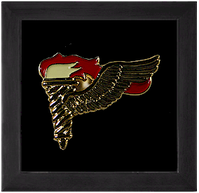
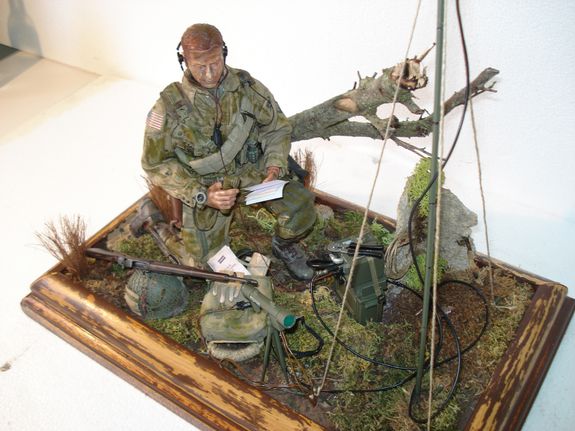
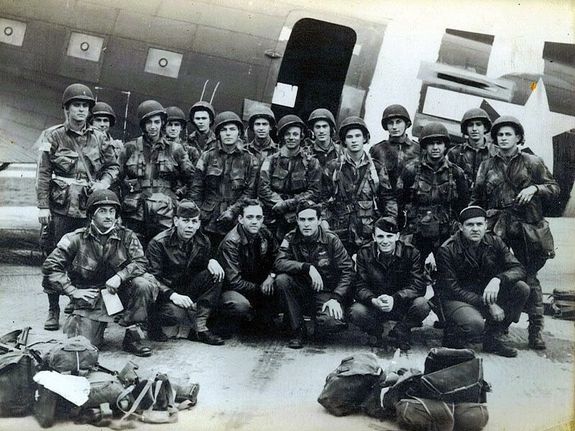
A pathfinder is a paratrooper who is inserted or dropped into place in order to set up and operate drop zones, pickup zones, and helicopter landing sites for airborne operations, air resupply operations, or other air operations in support of the ground unit commander. Pathfinders use a wide array of skills including air traffic control, ground-to-air communications, sling load operations and inspections, and drop zone and helicopter landing zone support in order to ensure the mission is a success.
The first two American airborne campaigns, the drops into North Africa (Operation Torch) and Sicily (Operation Husky) did not make use of pathfinders. The jump into North Africa, which was made up of the men of the 509th Parachute Infantry Battalion (PIB), resulted in its men being scattered to places such as Algeria, Gibraltar, and Morocco when they ran into bad weather and got lost. The next major airborne operation took place in the invasion of Sicily in July, 1943. Many of the same problems were encountered, as the men were scattered as far as 65 miles from their drop zones, due to high winds and poor navigation. In fact, some of the paratroopers landed so far off course that it would be a matter of weeks before they finally found their way back to Allied lines.
Sicily and Italy
After the serious problems uncovered during the parachute drop in the Allied invasion of Sicily, Allied high command questioned the utility of parachute infantry primarily because of the difficulty of dropping the infantry as cohesive units rather than as scattered groups. A review of procedures and methods resulted in the establishment of the pathfinder teams to aid navigation to drop zones. In fact, the pathfinder forces were only formed about a week in advance of the jump at Paestum, Italy on September 13, 1943. When the majority of the pathfinders landed directly on target, they were able to set up their radar sets and Krypton lights on the drop zone. A quarter of an hour later, the main body of paratroopers from the 504th Parachute Infantry Regiment (PIR) landed right on the middle of the drop zone.
The same night, the newly formed pathfinder detachment from the 509th PIB saw their first action in that capacity at Avellino, Italy However, unlike the successful pathfinders at Paestum, those at Avellino had markedly less success. However, this was not their fault, as the mountainous terrain surrounding the area deflected the radar signals and caused the pilots to become disoriented.
Normandy
Not until June 6, 1944, D-Day, would the airborne and pathfinder forces see combat again as part of Operation Overlord. Pathfinders taking part in the Allied parachute assault on Normandy, France on 6 June 1944, were trained by the Pathfinder School at RAF North Witham of which the USAAF designation was Army Air Force Station 479. At 21.30 hours on 5 June, about 200 pathfinders began to take off from North Witham, for the Cotentin Peninsula, in 20 C-47 aircraft of 9th Troop Carrier Command Pathfinder Group. They began to drop at 00.15 on June 6, to prepare the drop zones for the 82nd and 101st Airborne Divisions. They were the first US troops on the ground on D-Day. However, their aircraft were scattered by low clouds and anti-aircraft fire.
Many never found their assigned landing zones. Some of the landing zones were too heavily defended. Some were flooded. The low clouds and extremely intense anti-aircraft fire caused the pathfinder sticks to be dropped off course, with only one stick landing in the correct place (Ambrose, p. 196). Their radar beacons did work somewhat effectively; even though the pathfinders set up their equipment off course, many of the sticks of follow up paratroopers landed clustered near these beacons. However, the lights proved ineffective, as most were not set up due to the clouds and misdrops of the pathfinders.While the bad weather and heavy anti-aircraft curtailed the effectiveness of the pathfinder teams on D-Day, the overall airborne drop was a success. This was true because the misplacement and scattering of the airborne forces deceived the German High Command, convincing them that there were far more American parachutists present than there actually were in France.
Southern France
The invasion of the South of France took place on August 15, 1944, in the form of Operation Dragoon (Rottman, p. 80). The 509th PIB, the 517th PIR, and the 1st Battalion of the 551st PIR formed the American airborne contingent of the invasion, dropping into the French Riviera in the early hours of the morning.As had been the problem with previous night drops, such as Normandy, the pathfinders here were misdropped when the planes carrying them got lost.
Further delays were encountered when these men had to find each other on the ground, work their way through a heavily wooded area near the town of Le Muy, and fight off German soldiers in the process.
Due to the ineffective placement of the pathfinders, the follow up waves of paratroopers were not dropped in the right place either. This was further exacerbated by pilot error, as many of the pilots opted to drop their paratroopers at too high an altitude; the result was that these men were widely scattered. Much like the paratroopers in Normandy, however, the overall operation was a success as the paratroopers still managed to accomplish their missions and capture their objectives in conjunction with the seaborne landing forces.
Holland
Operation Market Garden, which took place on September 17, 1944, was the next major airborne operation into Holland, the largest to date.The mission of the paratroopers was to capture a series of bridges from Best in the south, to Arnhem (by British paratroopers) in the north..
While the operation ultimately failed, due to delays among the ground forces, the airborne divisions accomplished most of their missions; this was due in large part to the efforts of the pathfinder forces. A combination of the drop taking place in broad daylight and the fact that the Germans were not expecting an airborne attack allowed the pathfinders to land on target and guide in the rest of the paratroopers to the proper location.This is especially remarkable, considering the fact that the number of pathfinder sticks and the number of men in each stick were reduced to the bare minimum (one per drop zone) for this drop.
Battle of the Bulge
During the Battle of the Bulge in December 1944, the 101st Airborn Division along with elements of other units was trucked to the Belgian town of Bastogne in order to secure and defend the town which contained a major road junction. By December 22, 1944, the units defending the town were surrounded and running low on supplies. Two sticks of pathfinders of the 101st Airborne Division were ordered to parachute into Bastogne to set up signal beacons to guide in a flight of planes to resupply the Allied units in that town; the resupply succeeded, thanks to the efforts of the pathfinders.This was a slightly different mission than what the pathfinders were trained however it fell within their core compentency of guiding aircraft to a particular location for the purpose of a parachute drop.
Interestingly enough there were pathfinder trained personnel in Bastogne however they were unable to perform the pathfinder duty without the equipment that were parachuted in with the pathfinders.
Into Germany
A similar mission was carried out by the pathfinders of the 506th PIR at Prüm, Germany, on February 13, 1945.Their objective was to set beacons to guide in planes to resupply the surrounded 4th Infantry Division, and they succeeded; this allowed the division to fight off the Germans surrounding them.
The only major airborne operation into Germany came on March 24, 1945, in the form of Operation Varsity, the crossing of the Rhine River by Allied paratroopers .Due to the fact that it was another daylight drop (navigation should not be a problem) and that the drop zones were heavily defended, pathfinders were not dropped prior to the main paratrooper forces in this operation.Instead, some set up beacons on the Allied side of the river, and others dropped with the main paratrooper force to set up smoke and panels as a final navigational aid.
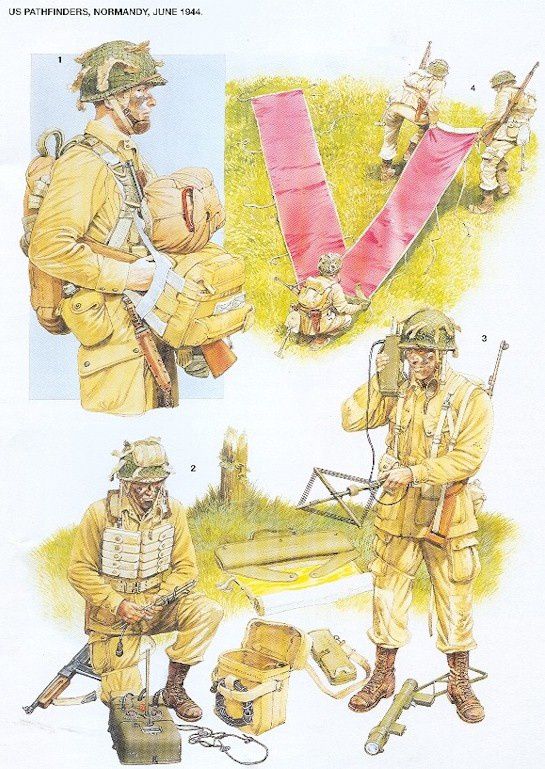

![]()
![]()

![]()





















/idata%2F0396584%2FKOREA%2F71910_korea_MIA1_800.JPG)
/idata%2F0396584%2FU.S.ARMY-POST-WW2%2Fphot4901a.jpg)
/idata%2F0396584%2FDRAWINGS-UNIFORMS-WW2%2F30-451-09b-2.jpg)
/idata%2F0396584%2FP-40%2F44FS000.jpg)
/idata%2F0396584%2FGERMAN-U-BOAT%2FBundesarchiv_Bild_101II-MW-1031-28-_Lorient-_U-31.jpg)
/idata%2F0396584%2FSOVIET-ARMY-WW2%2F1.jpg)




